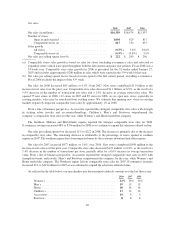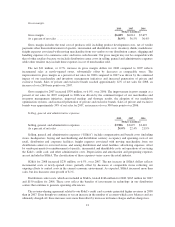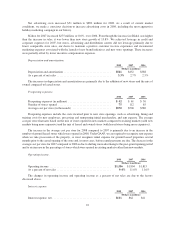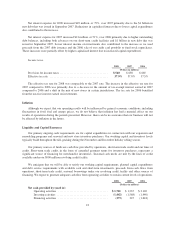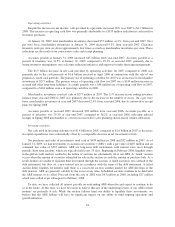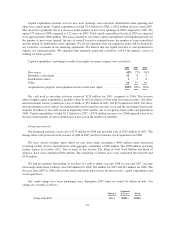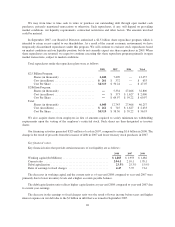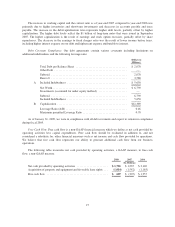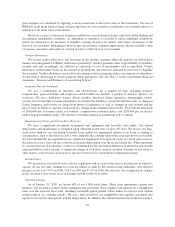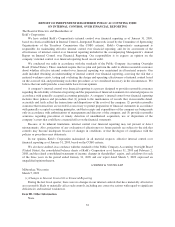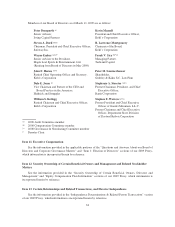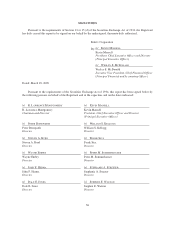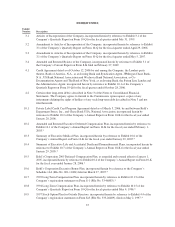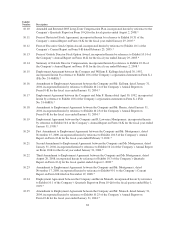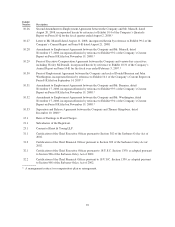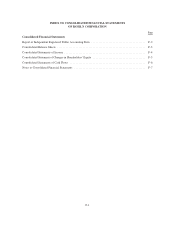Kohl's 2008 Annual Report Download - page 30
Download and view the complete annual report
Please find page 30 of the 2008 Kohl's annual report below. You can navigate through the pages in the report by either clicking on the pages listed below, or by using the keyword search tool below to find specific information within the annual report.the earlier of the date when we become legally obligated for the rent payments or the date when we take
possession of the building or land for initial setup of fixtures and merchandise or land improvements.
New Accounting Pronouncements
In January 2009, the FASB issued FASB Staff Position (“FSP”) EITF 99-20-1, “Amendments to the
Impairment Guidance of EITF Issue No. 99-20.” This standard prescribes that if the fair value of an
available-for-sale or held-to-maturity debt security is less than its cost basis at the measurement date, U.S.
Generally Accepted Accounting Principles (“GAAP”) requires that the reporting entity assess the impaired
security to determine whether the impairment is other than temporary. The adoption of this statement in the
fourth quarter of 2008 had no impact on our consolidated financial statements.
In May 2008, the FASB issued SFAS No. 162, “The Hierarchy of Generally Accepted Accounting
Principles.” This statement identifies the sources of accounting principles and the framework for selecting the
principles used in the preparation of financial statements of nongovernmental entities that are presented in
conformity with GAAP. We adopted this statement in the fourth quarter of 2008 without a material impact on our
consolidated financial statements.
In September 2006, the FASB issued SFAS No. 157, “Fair Value Measurements” (“SFAS No. 157”). SFAS
No. 157 defines fair value, establishes a framework for measuring fair value and expands disclosures about fair
value measurements. A portion of this statement was effective for 2008, while the remaining portion of the
statement is effective for our fiscal 2009. In February 2008, the FASB issued FSP FAS 157-1, “Application of
FASB Statement No. 157 to FASB Statement No. 13 and Other Accounting Pronouncements That Address Fair
Value Measurements for Purposes of Lease Classification or Measurement under Statement 13” and also issued
FSP FAS 157-2, “Effective Date of FASB Statement No. 157,” which collectively remove certain leasing
transactions from the scope of SFAS No. 157 and partially delay the effective date of SFAS No. 157 for one year
for certain non-financial assets and liabilities. In October 2008, the FASB also issued FSP FAS 157-3,
“Determining the Fair Value of a Financial Asset When the Market for That Asset Is Not Active,” which clarifies
the application of SFAS No. 157 in an inactive market and illustrates how an entity would determine fair value
when the market for a financial asset is not active. Although we will continue to evaluate the application of SFAS
No. 157, we do not currently believe adoption of the remaining portions of SFAS No. 157 will have a material
impact on our consolidated financial statements.
In February 2007, the FASB issued SFAS No. 159, “The Fair Value Option for Financial Assets and
Financial Liabilities—Including an amendment of FASB Statement No. 115,” (“SFAS No. 159”). This standard
permits entities to measure many financial instruments and certain other items at fair value. The objective is to
improve financial reporting by providing entities with the opportunity to mitigate volatility in reported earnings
caused by measuring related assets and liabilities differently without having to apply complex hedge accounting
provisions. A portion of this statement was effective for 2008, while the remaining portion of the statement is
effective for our fiscal 2009. We do not expect the adoption of the remaining portions of this statement will have
a material impact on our consolidated financial statements.
Item 7A. Quantitative and Qualitative Disclosures About Market Risk
All of our long-term debt at year-end 2008 is at fixed interest rates and, therefore, is not affected by changes
in interest rates. When our long-term debt instruments mature, we may refinance them at then existing market
interest rates, which may be more or less than interest rates on the maturing debt.
Borrowings under our revolving credit facilities are at variable rates and are affected by changes in interest
rates. For 2008, average borrowings under our revolving credit facilities were $40 million. If interest rates on the
average 2008 variable rate debt changed by 100 basis points, our annual interest expense would change by
$400,000, assuming comparable borrowing levels.
We were not a party to any derivative financial instruments in 2008, 2007 or 2006.
30


